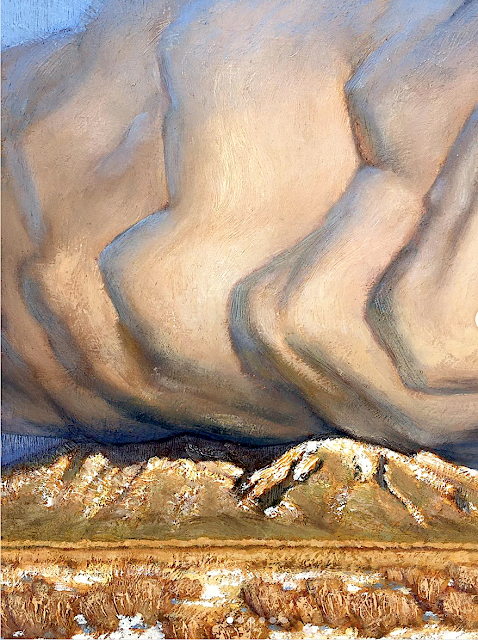ALFRED DE CURZON (1820-1895)
Mount Vesuvius (1,281 m- 4,203 ft at present)
Italy
In "Sorrente, devant la mer de Naples ", 1851, huile sur papier marouflé sur toile 24,5 x 33 cm,
Collection privée, courtesy Galerie d'Athènes, Paris
The painter
Alfred de Curzon is a French painter, grandson of Joseph-Emmanuel-Auguste-François de Lambertye and brother of Emmanuel Parent de Curzon. Alfred de Curzon's family is part of the aristocracy of western France. While he was a student, the painting Médée furieuse by Eugène Delacroix, exhibited at the Salon of 1838, made a strong impression on him. He tries his hand at pastel and decides to become a painter. He entered the 1 April 1840 at the School of Fine Arts in Paris in the studio of Michel Martin Drolling. On the advice of one of his classmates from the school, Louis Georges Brillouin (1817-1893), he changed studio to follow the lessons of Louis Cabat from 1845.
In 1849 he painted La Mort de Milon de Crotone. At the request of the Academy, he obtained from the minister the enjoyment of the pension of Rome for two years. There he met Alexandre Cabanel, Jean-Achille Benouville, François-Léon Benouville, Louis Français and Charles Busson who remained his friend. He travel to Greece in 1852 with the writer Edmond About and the architect Charles Garnier. Greek antiquity then strongly impregnated him and is found in many of his paintings.
He began at the Salon of 1843 with a painting entitled Landscape. He obtained a 2nd class medal in 1857, followed by recalls in 1859, 1861 and 1863. He was awarded a 3rd class medal at the Universal Exhibition of 1867.
Charles Baudelaire notes, in his Salon of 1845: "A serenade in a boat, - is one of the most distinguished things of the Salon. - The arrangement of all these figures is very happily conceived; the old man at the end of the boat, lying in the middle of the garlands, is a very pretty idea. - The compositions of M. Brillouin and that of M. Curzon have some analogy; they have this above all in common, that they are well drawn - and drawn with spirit."
Alfred de Curzon practiced all genres, but it was his landscapes that made him famous. Many drawings can be seen at the Sainte-Croix museum in Poitiers (France).
The mountain
Mount Vesuvius (1,281 m- 4,203 ft at present) is one of those
legendary and mythic mountains the Earth paid regularly tribute. Monte
Vesuvio in Italian modern langage or Mons Vesuvius in antique Latin
langage is a stratovolcano in the Gulf of Naples (Italy) about 9 km (5.6
mi) east of Naples and a short distance from the shore.
It is one of several volcanoes which form the Campanian volcanic arc.
Vesuvius consists of a large cone partially encircled by the steep rim
of a summit caldera caused by the collapse of an earlier and originally
much higher structure.
Mount Vesuvius is best known for its eruption in AD 79 that led to the
burying and destruction of the Roman antique cities of Pompeii,
Herculaneum, and several other settlements. That eruption ejected a
cloud of stones, ash, and fumes to a height of 33 km (20.5 mi), spewing
molten rock and pulverized pumice at the rate of 1.5 million tons per
second, ultimately releasing a hundred thousand times the thermal energy
released by the Hiroshima bombing. At least 1,000 people died in the
eruption. The only surviving eyewitness account of the event consists of
two letters by Pliny the Younger to the historian Tacitus.
Vesuvius has erupted many times since and is the only volcano on the
European mainland to have erupted within the last hundred years.
Nowadays, it is regarded as one of the most dangerous volcanoes in the
world because of the population of 3,000,000 people living nearby and
its tendency towards explosive eruptions (said Plinian eruptions). It is
the most densely populated volcanic region in the world.
Vesuvius was formed as a result of the collision of two tectonic plates,
the African and the Eurasian. The former was subducted beneath the
latter, deeper into the earth. As the water-saturated sediments of the
oceanic African plate were pushed to hotter depths in the earth, the
water boiled off and caused the melting point of the upper mantle to
drop enough to create partial melting of the rocks. Because magma is
less dense than the solid rock around it, it was pushed upward. Finding a
weak place at the Earth's surface it broke through, producing the
volcano.
he area around Vesuvius was officially declared a national park on June
5, 1995. The summit of Vesuvius is open to visitors and there is a small
network of paths around the mountain that are maintained by the park
authorities on weekends.
There is access by road to within 200 metres (660 ft) of the summit
(measured vertically), but thereafter access is on foot only. There is a
spiral walkway around the mountain from the road to the crater.
The first funicular cable car on Mount Vesuvius opened in 1880. It was
later destroyed by the 1944 eruption. "Funiculì, Funiculà", a famous
Neapolitan song with lyrics by journalist Peppino Turco set to music by
composer Luigi Denza, commemorates its opening.
_______________________________
2022 - Wandering Vertexes / Mountain painting
By Francis Rousseau



-%20-%20Vercors,%20hiver,%20paroi,%20gel%20(II),%20lavis,%202019,%2016x25cm-%20Vercors,%20hiver,%20paroi,%20gel%20(II),%20lavis,%202019,%2016x25cm.png)

,%20Savie%CC%80se%20in%20Valais%20(Morning%20in%20the%20mountains),%201912.png)

-Bushveld%20%201942%20CP%20.jpg)
%20-%20The%20Anva%CC%84r-i%20Suhayli%CC%84%20or%20Lights%20of%20Canopus-%201847-The%20Walters%20Art%20Museum15.jpg)

%20-%20Mount%20Haku,%20Kaga%20Province,%20%20Woodblock%20Print,%20%201862-%20in%20Sixty-eight%20Views%20of%20the%20Various%20Provinces,%201862.jpg)
%20%20Sorrente,%20devant%20la%20mer%20de%20Naples,%201851%20Huile%20sur%20papier%20maroufle%CC%81%20sur%20toile%2024,5%20x%2033%20cm%20coll%20prive%CC%81e%20courtesy%20gaelrie%20d'Athnes%20.png)

%20alta-montagna(monte%20binaco%20detail.jpg)
-%201889%20n.jpg)

%20-Nananu,-fiji-%20watercolor%20%2028.5%20x%2042%20cm.jpg)